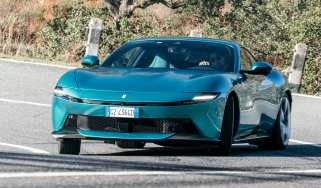Lotus Esprit S1 vs Essex Turbo vs Sport 300 vs S4S vs GT3 vs Sport 350
evo tests six of the best examples of Lotus’s much-missed supercar, the Esprit. But which one is the best?
It’s a blustery autumnal day in Paris, October 1975. Journalists are pouring into the exhibition hall, probably smoking and almost certainly looking for the best free food (we don’t smoke nowadays but our nostrils are still trained to sniff-out the best brekkie on press day). Today Ferrari will unveil its Dino replacement, the dramatic 308 GTB; on the Porsche stand a new 911 Turbo has pride of place, while Bertone will show the seriously cool Group 5 Fiat X1/9 Dallara (look it up). It’s an extraordinarily bold time despite the lingering effects of the recent oil crisis and stock market crash, and the sports car makers have a real swagger about them.
Lotus, you might imagine, would be a minnow struggling to get noticed between slinky new Ferraris, nutty wide-arched racers, crazy concepts and the unapologetic aggression of the Porsche 911 Turbo. But this was a different time and a different Lotus and nothing would light the show and the imagination quite like its new mid-engined sports car. A tiny wedge of origami-crisp lines straight from the imagination of Giorgetto Giugiaro on polished Wolfrace wheels became the instant and undisputed star of the show. They called it the Esprit.
A different time indeed. In the previous decade or so, Team Lotus had won six F1 Constructors’ championships; Ronnie Peterson was driving the wheels off a JPS Lotus 76 every other weekend, and the company had a visionary and mercurial engineer leading from the front… these were the halcyon days and Lotus was bristling with potential and bathed in glamour. In 1975, Lotus rocked.
More reviews
In-depth reviews
Reviews
- Analogue Lotus Elise SuperSport review: the Elise perfected?
- Lotus Elise Cup 250 review
- Lotus Elise review – is the featherweight sports car as good as ever?
- Lotus Elise Sprint 220 review – is this the sweet spot in the Elise range?
- 2016 Lotus Elise Cup 250 review - the fastest Elise ever
- Lotus Elise S Cup review - prices, specs and 0-60 time
- Lotus Elise S Club Racer review, specs and performance
It’s 2012, there’s a new Esprit in development, Lotus is back near the front in F1 with another Scandinavian with extraordinary talent behind the wheel, the Exige S is winning rave reviews… and yet we still don’t really know whether this iconic marque is safe, who’ll own it next week or next year, whether the new line of supercars will make production on target or at all… In the last year or so the Lotus story has been a farce, a tragedy, a waking nightmare for staff who must have yo-yo’d between excitement, dread and that achy, hollow fear you get when you haven’t revised for your maths A-level in the morning. But for now we’ve got our fingers and toes crossed and six of the most significant and wonderful Esprits at the new Hethel test track. This is a celebration – time to forget the soap opera and just do a bit of driving.
Few Esprit S1s are as beautifully presented as Ken Baird’s. In full Bond-spec white with tartan trim, new but correct period springs and dampers, and showing just 54,000 miles, it is captivating – and tiny. In fact the original Esprit weighs just 1006kg and has a very similar footprint to the new Exige S. However, its kneecap-high roofline, spindly pillars and 14-inch alloys make it seem much smaller and more delicate. The tiny dimensions don’t detract from the drama though. Of all the cars here, the S1 seems the most exotic – there’s not a single conceit or bolt-on flourish, but that shape is enough.
The chassis beneath is a simple steel backbone, with a tubular subframe cradling the tiny longitudinal 907 four-cylinder engine and the five-speed transaxle borrowed from the Citroën SM/Maserati Merak, with double-wishbone suspension at the front and trailing arms with transverse links at the rear. That engine, Lotus-developed but seen previously in the Jensen-Healey, produces just 160bhp and 140lb ft. Lotus claimed the Esprit would reach 138mph and zip to 60mph in 6.8 seconds, but road testers found those numbers impossible to match. No, the S1 was always regarded as underpowered, but even in ’76 (deliveries didn’t start until June ’76 at a price of £7883) there was no doubting the Esprit’s dynamic brilliance…
I roll out onto smooth black tarmac where until recently there was a hotch-potch of crumbling concrete, sunken asphalt and collapsed potholes, reminding myself that 37 years have passed since those early road tests. It’s freezing cold, but the sun is dazzling and Hethel has never looked better – nor have I ever been able to take in so much of its detail. The view through the flat, near-horizontal windscreen is extraordinary. That’s if you can take your eyes away from the crazy cabin, a riot of converging lines, green and red velour, dinky wooden ball atop an elegant gearlever, thick spur of single-spoke steering wheel, and green-faced Veglia dials set within a winged instrument binnacle. You feel millimetres above the ground. And like the coolest person in Norfolk; possibly the world.
Even on this new, smooth surface the big thick-rimmed steering wheel wriggles and writhes, heavy at very low speeds but quickly lightening and bursting with detail just like an Elise’s. The ’box is click-click sweet and tight, the non-servoed brakes feel firm and responsive and the four-cylinder engine revs cleanly with a deep, bassy tone – not exotic exactly, but hard-working, pure. That word again, and it really encapsulates the entire experience. The S1 feels light, alive with agility and poise, and with a chassis that errs towards understeer but also reacts to steering, throttle and brake inputs to leave you fully in charge.
I’d somehow expected the S1 to be pretty horrid but this beautiful example really does feel like the progenitor for all the Elise and Exiges that I’ve ever driven. You drive it with your fingertips, gently up to the limits of its front tyres and no further (unless there’s a camera pointing your way and a kind owner egging you on), and with a smile as wide as Giugiaro’s lapels in 1975. Of course it’s dated by a lack of grip and body-roll that you just don’t compute with a driving position so low and a chassis of this configuration. And the performance is no more than modest. However, I’m delighted and amazed by the little S1 and excited to see where the Esprit goes from here.
Our next stop skips the S2, a car that saw detail changes and an increase in engine size to 2.2 litres from May 1980, and goes straight to the Essex Turbo. The delicacy and understatement are gone; in their place exaggeration and aggression. It’s not nearly so beautiful, but can you honestly say the blue-red-chrome livery, deep-chinned styling, deep-dished cross-spoke alloys and those big tyres with GOODYEAR picked out in white don’t make something deep inside you want to yell your approval and jump into the hideously padded red leather seats and drive off into a tobacco-filtered sunset? I love it. Fewer than 50 Essex Turbos were made, and this 28,000-miler owned proudly by Barrie Cornes must be the very best in the world.
Only a handful of years separate these two cars, but already the Esprit has plotted a new path towards a more traditional supercar formula. The bigger tyres mean much more steering weight; the gearbox has added heft, and that joyous litheness is gone. However, to lament what’s been lost is to ignore what’s been gained: drama and speed and a sense that you’re in a perfect snapshot of 1980 and at the start of the Esprit’s development into something ferociously quick. The Essex isn’t that car but it is exciting and physical and, although it retains a similar mild-understeer balance, you sense it’s a car you could bully and cajole and that it’d be happy to get its hands dirty with you.
The performance is also on another level, the dry-sumped 2.2 producing 210bhp and 200lb ft, allowing Motor to record 0-60mph in 5.6sec. The delivery probably felt super-boosty 32 years ago but it’s nothing in the world of 997 Turbos and the like and you can happily let the turbo come in hard mid-corner without upsetting the car’s balance, at least in these dry conditions. Interestingly, the Essex has a modified chassis with improved rear suspension and designed to accommodate a V8 that was already in development…
So the S1 shows just how dynamically right the Esprit has always been, the Essex how it morphed from sports car to supercar, but the remaining Esprits in our group – the fearsome Sport 300 and Sport 350 models, the slightly more habitable S4S and the back-to-basics GT3 – are much closer in spirit. The Sport 300 came first and is nothing less than a homologation special for the Esprit GT1 car that raced at Le Mans in 1993. Based on the 264bhp S4, the Sport 300 was lighter, had a stiffer chassis with heavy cross-bracing over the reworked engine, four-piston AP brakes, huge OZ alloys and a vastly wider rear track that necessitated those gorgeous tacked-on ’arches. With 302bhp at 6400rpm and 287lb ft at 4400rpm and just 1243kg to push, it’s probably the most extreme Esprit there’s ever been and just 64 were produced.
The S4S came soon after in ’94 and was intended to capture some of the Sport 300’s fury but with a bit more luxury. With 300bhp at 7000rpm and 290lb ft at 4100rpm, it could be the real sweet-spot of the range and it’s the Esprit I always used to daydream about – that sweeping rear wing is so evocative. In ’96 – after the launch of the long-awaited Esprit V8 – Lotus created the 2-litre, 240bhp four-cylinder GT3 model. That might seem an odd move but the V8 had received a lukewarm reception and the GT3 gave an exciting and considerably cheaper entry level for Esprit ownership. Even so it was still just shy of £40K. Ironically, the magazines – which had been crying out for a V8 for years – loved this new four-cylinder model. Be careful what you wish for and all that.
Nobody moaned much about the 1999 V8-powered Sport 350, though. Here was the Esprit returning to the Sport 300 formula and turning up the aggression to 11. With magnesium wheels, carbon sprinkled here and there and the granddad of all rear wings, the Sport 350, limited to just 48 units, was the V8 delivering on all it had promised and mugging anything from Italy that happened to roll past. This very magazine suggested it was the greatest Esprit ever when we first drove it just before the turn of the millennium. No pressure, then.
It’s the oldest of this quartet, the 300, also owned by Esprit-nut Ken Baird, that really grabs and holds my attention. Those incredible three-piece wheels, wrapped at the rear in vast 315/35 ZR17 Goodyear GS-C tyres, the swollen ’arches – it just looks as hard as nails. Inside all is black, the seats are hard but superbly supportive, the suede-covered steering wheel is small and thick and when you start it up it has that hollow, angry motorsport edge. It’s a quantum leap on from the S1 and Essex, as you’d expect, and it feels authentically motorsport-derived. The ride is very firm, the steering now power-assisted but with incredible feel and that nice weightiness around the straight-ahead that makes you imagine front wheels leant-in with negative camber. The whole structure feels tangibly stiffer, and the Sport 300 reacts like an impatient racer. It’s also the only Esprit here with a limited-slip differential and that brings a newfound adjustability, made all the more critical by the way the boost just ramps up and up and UP. I’m listening to my voice-notes now, and of the Sport 300 engine I simply splutter, ‘Bloody hell, it’s mad at the top end.’
It is mad, too, but it retains that wonderful balance demonstrated by the early cars, clean turn-in bleeding away into gentle understeer and then tightening as the boost keeps on coming, until you need a bit of correction as the diff locks up and the fat rear Goodyears smear progressively across the track. I absolutely love how exotic and specialised it feels, its performance and its accessibility and, most of all, the encouragement it gives you to drive right at the limit. I climb out really coveting a Sport 300. Shame they’re already perhaps the most sought after of all Esprits and that prices are probably upwards of £40,000 now. Though in the context of something like a 964 or 993 RS that still seems like a genuine bargain.
Cliff Ledger’s S4S isn’t quite as rabid nor as demanding as the Sport 300, and prices are closer to £20,000, but it still has that supercar feel. Most of the 300’s strengths are present and correct – the gorgeous steering, which has so much light and shade but never seems to kick back, and the easy-going balance, although grip levels are predictably lower and there isn’t quite the scope to adjust the car on the throttle with no lsd. This example adds brilliant brakes, too. I’ve read nothing but bad things about Esprit brakes over the years so perhaps this S4S is a freak, but the pedal is almost rock-solid, with a short and decisive travel. The engine doesn’t quite have the feral boost at the top end that so characterises the 300 but it’s a pretty good facsimile and much more attainable.
If only it had as sweet a gearchange as the S1. And without the 300’s obvious motorsport tendencies there’s no hiding that the interior is… how can I put this politely? Well let’s just say it’s very ‘handmade’. Of course this test is naturally biased towards the more track-orientated machines, as for reasons of time we’re restricted to driving only at Hethel. I have a sneaky feeling that the more subtle and supple S4S, which can’t help but live in the shadow of the Sport 300 here, might work even better on the road. Even so it’s a deeply desirable car and yet another great Esprit. Remind me again, why did Lotus let this formula die?
So to the Sport 350 – not a homologation special, more a two-fingered salute to those who hadn’t been convinced by the Esprit V8, and a pukka supercar to stare-down the likes of the Porsche 996 GT3. It looks sensational and I can’t wait to get in a scrap with it. That’s what it feels like, too. With 349bhp and weighing just 1300kg, the Sport 350 has a knock-out punch – back in 1999 we recorded 4.3 seconds to 60mph and 9.9 to 100mph. However, it doesn’t quite have the manic feel of the Sport 300 at the top end. More interesting is the chassis, which feels utterly different. Where all the other Esprits feel very controlled, very stable through transitions, and corner in a very measured, cohesive way, the 350 is clearly working harder to contain the weight of its engine. You can almost sense the cam covers somewhere up above your shoulders creating roll oversteer, eroding that turn-in accuracy and promising to get out of hand if you need to flick to the opposite direction. And with a very abrupt throttle it’s tricky to blend one corner into another with precisely the revs you need to help balance the car.
Ultimately Trevor Skedge’s Sport 350 is the most intimidating car here and it feels the heaviest – or, perhaps more accurately, the least in control of its mass – when you start to push on. After the transparency of the other cars it’s odd to find yourself in limbo after turning-in, waiting for the rear of the car to settle then gently trying to get the torque on to the road without wheelspin (no lsd here) and a scrappy snatch of oversteer. It’s definitely exciting, but it’s patently not the best Esprit here.
The GT3 just might be. It gets back to the nub of the Esprit experience with wonderful steering accuracy, a supple ride and a fluidity and balance that really is masterful. The 2-litre engine needs lots more revs than, for example, the S4S, but that only adds to the fun and subconsciously I just drive this car more quickly, more smoothly and plain better than anything else today. It just seems so sweetly sorted and, aside from a pretty awkward gearbox (the later, Renault-sourced ’box is nowhere near as sweet as the earlier Citroën unit) and the lack of torque in slow corners, which tends to make the car feel a bit understeery, the GT3 feels absolutely fabulous. Light and agile, trustworthy and adjustable, and keen to be driven on its doorhandles everywhere. Owner and Esprit expert Gary Clark sums it up perfectly: ‘To me it just feels so right.’
To drive such beautifully preserved and prepared Esprits back-to-back has been fascinating. Previously I’d only ever driven slightly ropey examples and I have to say I wasn’t overwhelmed at the prospect of this Esprit supertest. But now I understand. I love the S1’s purity and feedback, the Sport 300’s intensity, the Essex Turbo’s character, the Sport 350’s attitude, the S4S’s blend of all those strengths and the GT3’s ability to make 240bhp feel impossibly exciting. I only regret that Lotus hasn’t made an Esprit for a decade now and that we don’t know when or if the next one will arrive. For now I’d suggest you go and search for a GT3 or a Sport 300 (budget-dependent), tuck them up in your garage and take them for a drive whenever you want to experience mid-engined dynamics at their finest. Before you buy that dream 911 or Ferrari, go and find an Esprit that’s been loved and drive it. I promise you’ll be surprised.
Huge thanks to Ken Baird, Gary Clark, Trevor Skedge, Cliff Ledger and Barrie Cornes for allowing us to drive their fabulous Esprits. A special mention also to Bibs from thelotusforums.com, which has 11,000 registered users, all of them Lotus owners or fans. If you’re thinking of buying any Lotus, it’s an invaluable resource and well worth a visit.




